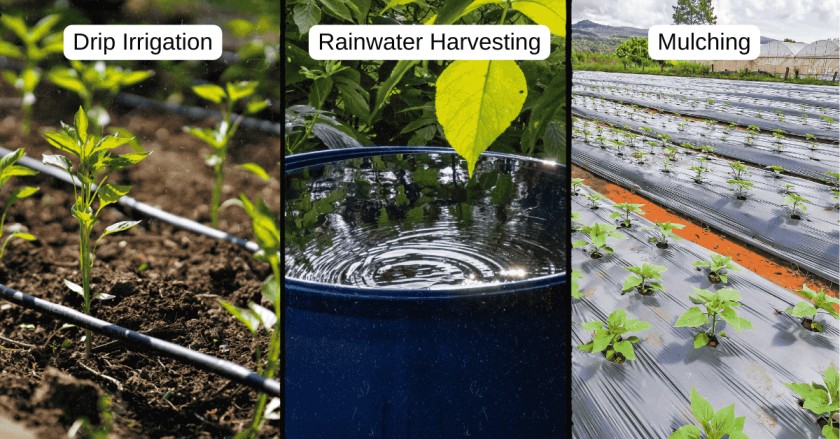As the world faces environmental challenges, sustainable farming has become more important than ever. By adopting eco-friendly practices, farmers can grow healthier crops, protect natural resources, and contribute to a greener planet. Whether you’re a small-scale farmer or managing large fields, these five sustainable farming practices can make a big difference.
Here are the 5 Sustainable Farming Practices for Healthier Crops and a Greener Planet:
1. Practice Crop Rotation

Crop rotation is a time-tested method that involves growing different crops in the same area over sequential seasons. This practice helps:
- Improve Soil Health: Different crops have varying nutrient needs, which prevents soil depletion.
- Reduce Pests and Diseases: Rotating crops disrupts the life cycles of pests and pathogens.
- Boost Yields: Healthier soil leads to better crop growth and higher productivity.
Example: Follow nitrogen-hungry crops like corn with nitrogen-fixing crops like beans or peas.
2. Use Organic Fertilizers and Compost

Chemical fertilizers can harm the environment and degrade soil quality over time. Switching to organic alternatives offers numerous benefits:
- Enhance Soil Fertility: Compost and manure add essential nutrients and improve soil structure.
- Promote Microbial Activity: Organic matter supports beneficial microorganisms that aid plant growth.
- Reduce Pollution: Organic fertilizers minimize the risk of water contamination from chemical runoff.
Pro Tip: Create your own compost using kitchen scraps, yard waste, and livestock manure.
3. Implement Water Conservation Techniques

Water is a precious resource, and efficient irrigation is key to sustainable farming. Here’s how to conserve water:
- Drip Irrigation: Deliver water directly to plant roots, reducing waste and evaporation.
- Rainwater Harvesting: Collect and store rainwater for irrigation during dry periods.
- Mulching: Use mulch to retain soil moisture and reduce the need for frequent watering.
Pro Tip: Monitor soil moisture levels regularly to avoid overwatering or underwatering.
4. Adopt Integrated Pest Management (IPM)

IPM is an eco-friendly approach to pest control that combines multiple strategies:
- Biological Control: Introduce natural predators like ladybugs to control pest populations.
- Cultural Practices: Use crop rotation, intercropping, and resistant varieties to deter pests.
- Mechanical Methods: Handpick pests or use traps to reduce their numbers.
- Organic Pesticides: As a last resort, use natural pesticides like neem oil or insecticidal soap.
Pro Tip: Regularly inspect crops for early signs of pest infestations to take timely action.
5. Embrace Agroforestry

Agroforestry integrates trees and shrubs into farming systems, offering a range of benefits:
- Soil Conservation: Tree roots prevent soil erosion and improve soil structure.
- Biodiversity: Trees provide habitats for beneficial insects, birds, and other wildlife.
- Climate Resilience: Trees sequester carbon, reduce greenhouse gas emissions, and provide shade for crops.
Example: Plant fruit trees or nitrogen-fixing shrubs alongside crops to create a diverse and resilient ecosystem.
Why Sustainable Farming Matters
Sustainable farming isn’t just good for the environment—it’s also good for farmers and consumers. By adopting these practices, you can:
- Increase Long-Term Productivity: Healthy soil and ecosystems lead to consistent yields over time.
- Reduce Costs: Efficient resource use lowers expenses on water, fertilizers, and pesticides.
- Meet Consumer Demand: More people are seeking sustainably grown food, creating market opportunities.
Also read: 10 Non-Traditional Agriculture Business Ideas to Boost Your Income
A Note on AI and Transparency
This article was created with the assistance of AI tools to ensure clarity, accuracy, and a user-friendly structure. However, the content has been carefully reviewed and edited by a human to align with Google’s guidelines and provide genuine value to readers.
Final Thoughts
Sustainable farming is a win-win for farmers, consumers, and the planet. By implementing practices like crop rotation, organic fertilization, water conservation, IPM, and agroforestry, you can grow healthier crops while protecting the environment.
Which of these practices are you already using? Share your experiences or questions in the comments below—we’d love to hear from you!
Shivank patyal is a versatile blogger with a B.Sc. in Plant Biotechnology and 5 years of experience writing about agriculture, sustainability, and entertainment topics. With expertise in digital marketing and field experience in crop cultivation, Shivank provides practical insights for farmers while also engaging readers with content on diverse subjects. Passionate about sharing knowledge, Shivank combines education and creativity to connect with a wide audience.

Leave a Reply